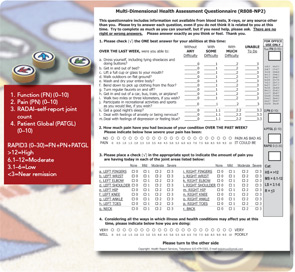Unexpected Observations from a Box of Records
My appreciation of the value of the evolving MDHAQ was greatly accelerated in July 1982 by results of a review of long-term outcomes of RA, which began as a summer research project by a Vanderbilt medical student, Lee Payne. William Sale, MD, an orthopedic resident there, had performed an unusually extensive evaluation, including patient questionnaires, on 75 RA patients nine years earlier in 1973, and gave me a box of their records (labeled “Jim Beam”) before he left Vanderbilt. Our investigation of the patients nine years later revealed five unexpected observations, which presented novel implications for care of patients with RA:9
- Long-term outcomes of RA were much more unfavorable than was generally recognized at the time, with severe functional declines and premature mortality rates, predicted by severity of clinical status, rather than by adverse effects of therapies.
- Treatment at that time, although described as “remission-inducing” in textbooks, was not adequate for favorable long-term results.10
- The most significant quantitative clinical predictor of premature mortality was physical function assessed on a patient questionnaire, rather than radiographs or laboratory tests. Poor physical function scores identified a risk of less than 50% five-year survival in RA similar to stage IV Hodgkin disease or three-vessel coronary artery disease (see Figure 3). Therefore, it seemed reasonable that patient self-report questionnaire scores should be available for clinical decisions at all usual care visits.
- Formal education level was more significant in predicting premature mortality than laboratory tests or radiographs (see Figure 3), indicating the importance of socioeconomic status, patient actions, and self-management in the outcomes of RA (and all chronic diseases).11
- Results of relatively short-term clinical trials with agents such as gold salts and penicillamine did not translate into favorable long-term outcomes, indicating a need for long-term observational studies to analyze results of treatment and outcomes of RA (and all chronic diseases).
The first two observations—that RA was a severe disease with high rates of work disability and increased mortality and that the therapies available at that time were inadequate—were widely accepted by the rheumatology community; similar reports from other sites helped foster new treatment approaches. The other three observations, however, have been accepted much more slowly over the last 25 years. Patient self-report questionnaires—the most significant predictor of work disability and mortality in RA—have been introduced into only about 20% of rheumatology usual care settings, although at an accelerated rate in recent years. The importance of socioeconomic variables in health, though widely recognized far beyond RA, remains omitted from most reports of clinical trials and outcomes.11 Observational databases have been established to monitor long-term outcomes, but generally as research activities, rather than in the infrastructure of usual care. This seems unfortunate, because simple programs for self-report questionnaires allow documentation of the course of every rheumatology patient, without a need for specialized registries, although analyses of data in groups require additional expertise.


